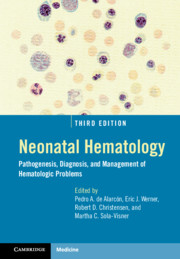Book contents
- Neonatal Hematology
- Neonatal Hematology
- Copyright page
- Contents
- Foreword
- Preface
- Contributors
- Section I Developmental Hematology
- Section II Bone Marrow Failure and Immune Disorders
- Section III Erythrocyte Disorders
- Chapter 6 Newborn Genetic Screening for Blood Disorders
- Chapter 7 A Guide to Identifying the Cause of Anemia in a Neonate
- Chapter 8 Anemia of Prematurity and Indications for Erythropoietin Therapy
- Chapter 9 Hemolytic Disease of the Fetus and Newborn
- Chapter 10 Neonatal Hemolysis
- Chapter 11 Polycythemia and Hyperviscosity in the Newborn
- Section IV Platelet Disorders
- Section V Leucocyte Disorders
- Section VI Hemostatic Disorders
- Section VII Neonatal Transfusion Medicine
- Section VIII Neonatal Oncology
- Section IX Miscellaneous
- Index
- Plate Section (PDF Only)
- References
Chapter 11 - Polycythemia and Hyperviscosity in the Newborn
from Section III - Erythrocyte Disorders
Published online by Cambridge University Press: 30 January 2021
- Neonatal Hematology
- Neonatal Hematology
- Copyright page
- Contents
- Foreword
- Preface
- Contributors
- Section I Developmental Hematology
- Section II Bone Marrow Failure and Immune Disorders
- Section III Erythrocyte Disorders
- Chapter 6 Newborn Genetic Screening for Blood Disorders
- Chapter 7 A Guide to Identifying the Cause of Anemia in a Neonate
- Chapter 8 Anemia of Prematurity and Indications for Erythropoietin Therapy
- Chapter 9 Hemolytic Disease of the Fetus and Newborn
- Chapter 10 Neonatal Hemolysis
- Chapter 11 Polycythemia and Hyperviscosity in the Newborn
- Section IV Platelet Disorders
- Section V Leucocyte Disorders
- Section VI Hemostatic Disorders
- Section VII Neonatal Transfusion Medicine
- Section VIII Neonatal Oncology
- Section IX Miscellaneous
- Index
- Plate Section (PDF Only)
- References
Summary
Polycythemia of the newborn is first mentioned in the Bible as Esau and Jacob are described at the time of their birth. Esau appears to be the recipient of a twin-to-twin transfusion (Genesis 25:25: “The first one emerged red …”). There is little in the modern medical literature concerning polycythemia in the newborn until the early 1970s [1–5]. During this time, there were a number of case reports and small series of infants with various symptoms that were thought to be secondary to an elevated hematocrit and blood viscosity. It was not until the 1980s that several investigators systematically examined the association between polycythemia, hyperviscosity of the blood, and organ-system dysfunction. These studies have done much to enlighten our understanding of the relationships between abnormalities of the hematocrit, blood viscosity, organ blood flow, and organ function. The dissemination of this knowledge has provided a clinical approach that is based on well-defined data and has clarified the role of polycythemia as an etiologic factor for organ dysfunction in the neonate.
- Type
- Chapter
- Information
- Neonatal HematologyPathogenesis, Diagnosis, and Management of Hematologic Problems, pp. 185 - 200Publisher: Cambridge University PressPrint publication year: 2021

